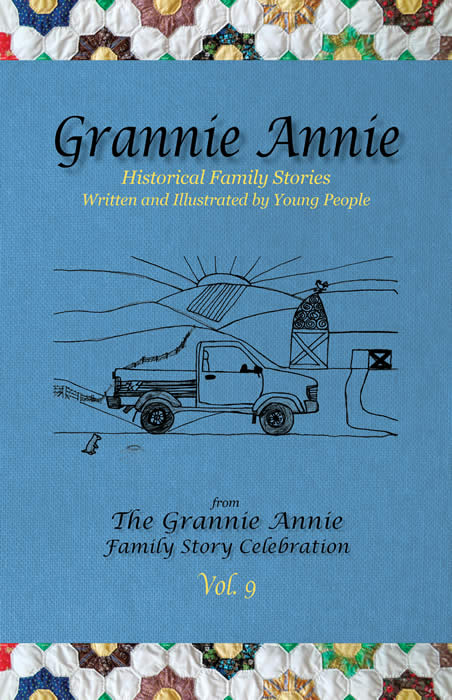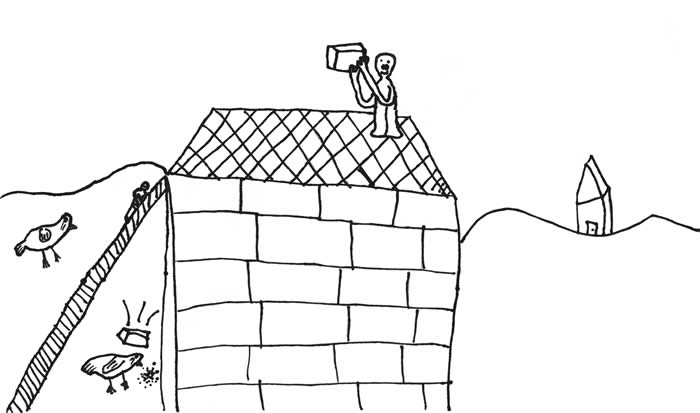Selected Stories from
The Grannie Annie Family Story Celebration 2013/2014
— Stories dated 1948–1962 —
1.
Stuck in a Silo
Quincy, Illinois, USA; c. 1948
My grandma Renee grew up on a 200-acre farm. She was a good little girl, and she liked to play in the smelly barn and to play hide-and-seek in the acres of corn. One day Grandma’s friend Shelly came over and was tired of the barn and the field. Out of the corner of her eye, Grandma saw the gigantic silo, which was at the front of the farm. She thought it was full of ripe corn, and they hoped for adventure. The girls quickly ran to the silo.
The silo was so enormous, the girls had to climb a ladder to get in. When they reached a hole where they could climb in, they looked at each other. My grandma said, “You go first.”
Shelly took the first step, and right when she stepped in, she knew something was wrong. The corn was soggy and wet! Shelly started to sink very slowly! It was like a mound of corn quicksand.
Immediately Grandma knew she needed help, so Grandma climbed down the ladder as fast as she could and hurried to the house. She went to the phone — which was a party-line phone, so all of her neighbors could hear her — and started yelling, “Help! Help! My friend is stuck in my silo!”
A bunch of neighbors scurried to the house. Shelly was about chest-deep when the neighbors got to the silo. Her life was in jeopardy! The neighbors were frantic, but one neighbor had thought ahead and brought a rope. He frantically put it around Shelly’s arms and pulled her out. The neighbors stood at the bottom of the silo yelling, “Is she okay?” Shelly was so scared she couldn’t stop shaking.
Grandma and Shelly got in an incredible amount of trouble. As punishment, my grandma did many chores, and I can’t believe this, but my great-grandma was so angry she actually said some “bad words”!
Shelly and Grandma learned their lesson: Don’t go into the silo! The silo still stands there today — but no one dares to go into it.
Grace Schlueter; Missouri, USA
2.
Bricks vs. Chickens
Collinsville, Illinois, USA; c. 1950
Angelo was a troublemaker. He did countless practical jokes, and his favorite pastime was playing pranks on unfortunate friends and family members. No one felt safe turning their back on him, because they might end up with a lizard down their shirt if they did. Though he played mostly simple pranks, he wasn’t notorious for being simple-minded. In fact, you were usually caught in his trap before you even realized he had one.
It was a warm summer day in Collinsville, Illinois, 1950. Nine-year-old Angelo Zavaglia was sitting on the front porch of his small white house, waiting eagerly for his cousin to arrive. What will my cousin be like? he thought. Will he be a troublemaker like me? His thoughts were interrupted as a dusty blue pickup truck bounced into the driveway. Angelo stood up, and his mother opened the front door and came out. Out of the truck jumped his aunt and uncle and his cousin Gregg. Gregg rushed to Angelo’s side.
“I’ve heard such great things about you!” exclaimed Gregg.
Angelo found that hard to believe. He waved Gregg inside, leaving his mom, aunt, and uncle to talk. “Are you a troublemaker, too?” asked Angelo.
Gregg shook his head. “What do you mean?” he asked. “If I was, my mom would still think I’m an angel. I’ve never even gotten spanked — not for anything!”
Angelo gaped. He had never gotten spanked — ever? Angelo had been spanked more times than he could remember.
Then a light went on in Angelo’s head. He waited until his uncle, aunt, and mother weren’t looking, and then pulled Gregg through the side door into the backyard. Angelo jogged over to the chicken house, which had many, many chickens strutting around it. By the time Gregg caught up to him, Angelo was already on top of the chicken house. Angelo waved for Gregg to join him. Gregg reluctantly climbed up with him, and stood up. Angelo held a brick in each hand. He handed one to Gregg.
“Throw it,” urged Angelo.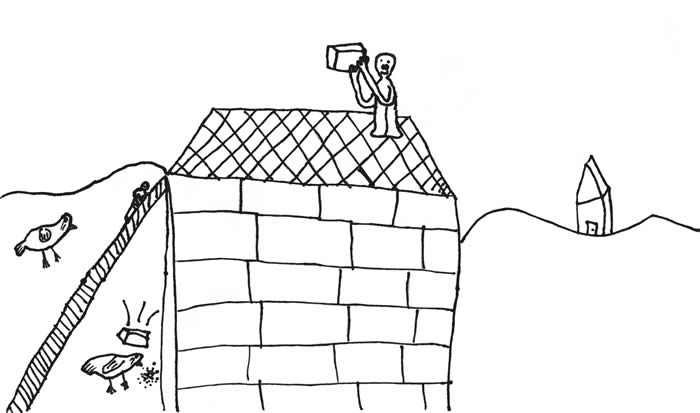
Gregg weakly tossed the brick, missing the chickens on purpose.
Angelo laughed, and handed him the other brick. “You have to throw hard and aim at a chicken,” he said.
Gregg threw the brick, this time only nearly missing a chicken, and a smile stretched across his face. Angelo handed him two more bricks. Gregg was so preoccupied throwing bricks at the chickens, he didn’t notice that Angelo had slipped back inside his house.
Moments later, Gregg’s mother dashed outside. “Gregg!” she screamed. Gregg turned. His mother came lunging at him. “This is not what we do to our cousin’s chickens!” she yelled. Gregg’s mom dragged him off the chicken house and gave him a real hard spanking.
Angelo ran back into the house laughing. Now we’re even, he thought. Now we’ve both been spanked!
Angelo walked up to his room, new pranks and traps already forming in his head.
Raphaella Zavaglia, great-niece of Angelo; Missouri, USA
Illustrator: B. B. Williams; Missouri, USA
3.
Sausage Day
Graceville, Florida, USA; c. 1952
In 1952 six-year-old Katie lived on a seventy-two- acre farm in the panhandle of Florida with her parents, Park and Mattie Belle Register, and her five siblings, Jimmy, Nadine, Max, Gertha, and baby Charlene. Katie was the second-youngest in her family.
They had a cozy two-bedroom farmhouse. There were a barn, pens for their animals, and a large shed for their tools. There were large pecan trees growing in their yard that they liked to sit under when it was hot. A catfish pond was full of catfish, and sometimes they would go fishing in the evening when their chores were done.
They were always working on their farm. Some of the crops they grew were for themselves so they could have food. Some of the crops were to sell or trade. They grew peanuts, cotton, velvet beans, corn, okra, and cotton. They had to work hard every day from the late winter through the late fall.
When the late fall came, it was time to slaughter the hogs. Killing hogs was hard work and needed many helping hands. They lived in a farming community where many families had hogs that needed to be slaughtered to provide food for meals throughout the winter. All the neighbors helped each other. One day they would all come help slaughter the hogs at one house, and then the next time they would all go to another home to help. It was faster to help one another than to do it alone.
When it was time to slaughter Katie’s hogs, Katie’s mom woke her up at 3:00 a.m. to help make breakfast for the family. The neighbors started showing up at about 5:00 a.m. to help. Katie’s dad and some other men shot the hogs. Then they placed them in clean oil drums with boiling water and scraped the hair off. Everyone had a job to do.
Katie’s job was cleaning intestines to make sausage casings. Her partner was Miss Suzy. They washed the intestines with warm water two or three times. After the intestines were cleaned, Katie had to pull the intestines hard so Miss Suzy could cut them to make the sausage casings. Miss Suzy accidentally cut Katie’s fingers several times. Each time she cut Katie, Miss Suzy would say, “Oh, I’m sorry, honey.”
While Katie was painfully making the sausage casings, her grandfather was making the sausage. When he finished, Miss Suzy and Katie stuffed the casings with the sausage.
To finish their job, they hung the sausage in the smokehouse to “cook.” They did not have a freezer, so the smokehouse kept the meat from going bad.
Once they were finished, Miss Suzy said, “Bless your heart!” to Katie.
Katie thought, Bless my fingers!
The next day Katie showed her mother her fingers and said, “I want a new job.”
Her mother said, “Okay, sweetie.”
Katie learned to always help her family when they need help and to do her job without complaining.
Jefferson “Jake” Davis, grandson of Katie; New Jersey, USA
4.
The Ice Cream Escapade
Pilot Grove, Missouri, USA; c. 1952
The story starts on a hot summer day in 1952 when my grandpa Rich was outside with the neighbor kids. The group was enjoying the day, when they heard a big truck rumbling by on the big open road. The truck was passing through town on the way to the next stop to drop off more large buckets of ice cream.
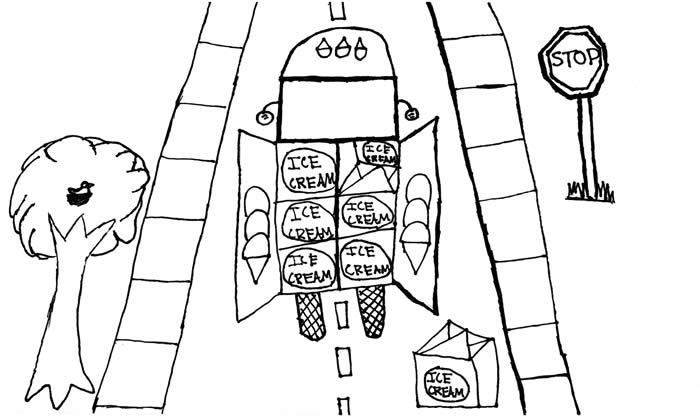 All of a sudden the back of the truck flew open, and a five-gallon tub of smooth, delicious ice cream came tumbling out and banged against the ground with a thud. The kids looked at each other in amazement, wondering what to do. They watched the ice cream with their beaming eyes. What luck they had that day, because it is not every day a tub of ice cream happens to fall into your possession. All of a sudden the back of the truck flew open, and a five-gallon tub of smooth, delicious ice cream came tumbling out and banged against the ground with a thud. The kids looked at each other in amazement, wondering what to do. They watched the ice cream with their beaming eyes. What luck they had that day, because it is not every day a tub of ice cream happens to fall into your possession.
The truck continued to roll on down the street, because the driver did not hear the ice cream when it hit the ground. All the kids ran to the bucket of ice cream in the road, opened it, and looked inside and found the savory chocolate ice cream. Their eyes widened, and smiles crept up their faces.
The children ran inside with joy, giddy as they skipped up to their parents. They told their parents the miraculous story, and the adults told the other siblings, who told some friends, who told the neighbors—and soon enough, everyone who lived on the block came outside with their old black pots and pans, and took turns scooping out their share of the ice cream.
The neighbors couldn’t let the ice cream go to waste, so they devoured it! Back then, most people did not have freezers, coolers, or places to keep things frozen, and they did not want the ice cream to just melt in the middle of the street. The neighbors had thought, What a nice sweet treat for a hot day. They all devoured the ice cream!
To this day, my grandpa still remembers the ice cream story and can almost taste that ice cream when he tells the story.
Emma Bell; Missouri, USA
Illustrator: Alexis Tounsand; Missouri, USA
5.
Bobby Frieda,
a Strong-Willed Woman
Manhattan, New York, New York, USA; c. 1953
My grandfather told me this story about my great-grandmother whom I call Bobby Frieda. My great-grandmother was an expert dressmaker. She was amazing! She worked in a place with over one hundred workers. She was the best out of all of them. When someone wanted a sample to hang in a store, they would use her work.
One time they got a huge order, and the boss said to her, “Stop what you are doing, and start working on this order this instant!!!!”
“I have to leave and light the candles to welcome the holy Sabbath,” she explained.
The boss replied, “Start now, or I will cut your pay.” His voice started rising as he continued. “I will fire you!” he screamed.
My great-grandmother said, “Fire me. I will only do it on Monday.”
The boss replied, “NOW!!!!!!!!!!!!!!!!!!!!!!!!!!!!!!!!”
“I don’t care! I won’t do it. Don’t threaten me — I know what I am worth,” she replied. “You can cut my pay. You can fire me. I won’t do it,” she answered.
The boss shouted and screamed, “Get out, now!”
“Okay, lose your best and favorite worker,” she replied.
“Do it now, or I will cut your pay!” he screamed one last time.
“Bye. I am out,” she answered, staring at him, straight in the eye.
I feel really, really proud to be a great- granddaughter of a lady who stood up to a strong and powerful boss. You just think about it. She could have said okay, feeling scared as a cat, but she stood up for herself. She ended up doing the work on Monday, but her boss was not so happy about it.
Etta Krinsky; New York, USA
6.
The Disk in the Sky
Hyderabad, Sindh, Pakistan; c. 1955
Knowledge is precious to the human race. Everything is a mystery to us, and many times we fail to find an answer. My grandpa Shafiq, who became a biomedical scientist, still cannot find answers to some of the mysterious happenings he witnessed as a child.
The Pakistani heat pounded onto Shafiq’s back, and this wasn’t even full blast — it was still early morning. Warm sand sifted around in the bottom of his sneakers as he sprinted across the landscape.
His competitors lined up, waiting for their turn to hit. This was one cricket match that neither team wanted to lose. The defensive team set up the players similar to an American baseball field. A batsman walked up to the plate; Shafiq stood waiting and ready in the outfield. The pitcher bowled the ball to the batsman, and the boy swung the bat like a golf club.
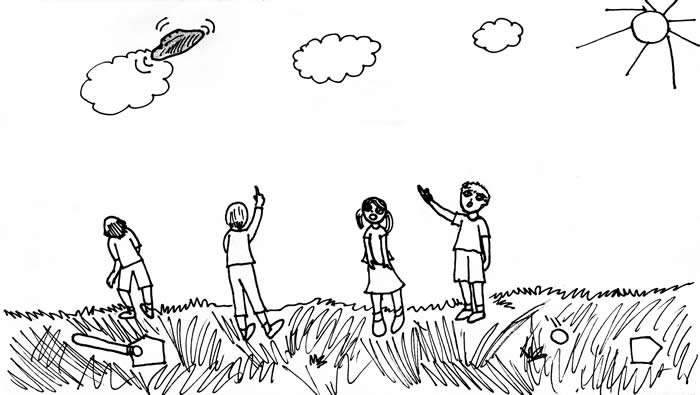 Smashing against the blade of the bat, the ball flew through the air and into the outfield. Shafiq raised his arms into the air, trying to line up his hands to make the catch. At the tip of his finger, he noticed a gray disk. It had to be about the size of an airplane, if not larger, but lacked flashing lights and unusual noises. The disk could have been a plate hovering in the air. The ball hit the ground behind Shafiq, and players began running around, scoring points, and cheering. But Shafiq continued to watch the disk with wonder. He raised his hand and pointed at the disk. His friends looked up and gasped. Smashing against the blade of the bat, the ball flew through the air and into the outfield. Shafiq raised his arms into the air, trying to line up his hands to make the catch. At the tip of his finger, he noticed a gray disk. It had to be about the size of an airplane, if not larger, but lacked flashing lights and unusual noises. The disk could have been a plate hovering in the air. The ball hit the ground behind Shafiq, and players began running around, scoring points, and cheering. But Shafiq continued to watch the disk with wonder. He raised his hand and pointed at the disk. His friends looked up and gasped.
Years later his friends chatted about the disk. Everyone had seen it, and yet nobody had a clue what it was. Nothing seemed to match up. And many years later, after all the training and studies and research Shafiq has done as a scientist, he still has no answer.
Not everything can be explained, no matter how hard we try. That is what makes knowledge so precious. This object can be explained only as a disk in the sky.
Sydney Kinzy; Missouri, USA
Illustrator: Rachel Liang; Missouri, USA
7.
Countering the Unfairness
Jiagou, Anhui Province, China; c. 1956–1959
My story took place from 1956 to 1959 in Anhui Province, China. At that time most Chinese families favored boys over girls, because they believed that once a woman married, she belonged to another family. As a result, my grandmother was not allowed to go to school. Her brother was allowed to go to school, but she wasn’t. She’d pleaded with her father uncountable times, and now was the time to take action.
It was a warm, sunny summer day as she walked down the “road” (dirt path). A perfect day for the school children! she thought bitterly. My grandmother knew that she should be cutting grass to be dried into hay, and she knew that the consequences would be severe if her parents caught her out there. She knew all that, but she ignored all of it. After all, school was her greatest wish, wasn’t it?
She located the village headmaster’s house and knocked on the door. The headmaster came out. My grandmother explained her situation, and the headmaster promised to go to her house later that day.
That night, under the rosy sky, the headmaster walked home, knowing that he had accomplished his task.
Meanwhile . . . at my grandmother’s house, her
father gave her a punishment for asking the headmaster to help and trying to get him to agree to let her go to school.
When fall came, her father was forced to let her go to school, because he had agreed when the headmaster had gone to his home. He would let her go, but only if she promised to do the cooking, do the gardening, do the laundry, feed the animals, collect grass for drying into hay, and do countless other housework jobs. Below is her schedule:
1. Wake up
2. Make breakfast
3. Go to school (walk barefoot across a rocky
1⁄2-mile “road”)
4. Walk back home from school
5. Study while doing chores
6. Make dinner
7. Go to bed (on the dirt floor)
The first month my grandmother went to school, she was excellent. So her father requested her to skip a grade. My grandmother objected. Her father said that if she didn’t skip a grade, she would be stupid and she shouldn’t go to school. So she could only agree to skip that grade. She kept up well in second grade and soon was excelling again. As a result, her father made her skip another grade.
In third grade, there were multiplication and division, as well as addition and subtraction. This time my grandmother took longer to achieve the third-grade standard status, but she made it and once again achieved first place.
After three hard years of elementary school, she was admitted to Fuli Normal School. She moved on to graduate from normal school* and eventually became the director of a child development center.
Her life was so successful just because she made her father let her attend school.
* A normal school was a school that trained high school graduates to be teachers, especially elementary-school teachers.
Jason Xu; Missouri, USA
8.
Slavery Escape
Bocas del Toro, Panama; Panama City, Panama; 1959–1962
As an eight-year-old girl, my grandmother was stolen and sold from the Ngöbe-Buglé Indian tribe in the jungle of Panama. A rich family was going to get a slave — who would become a runaway slave. This is the story of my abuela* and how she escaped from slavery.
In 1959, or when she was twenty-one, my abuela tried to run away barefoot from her owners’ house in Almirante in the province of Bocas del Toro, Panama. She traveled to the town priest. For safety she hid in his house until the police and owners showed up and knocked on the door. They interrogated the priest. As every terrifying moment passed away, the more curious my abuela became. Out of curiosity, she peeked out the door. The police saw her and pulled her away to the owners, who told the police she was only sixteen. The priest stood up for her and convinced the police to set her free.
Later, after everyone left, the priest told her to get a birth certificate. She did not know how, since she had not been exposed to the outside world. So the priest helped her get one.
She moved to Panama City, where three years later she met my grandpa and got married, even with a language barrier of my grandpa knowing only English. He was there just to serve at the U.S. base in Panama. They soon moved to America for their new life as a veteran and a traumatized free slave.
My abuela learned three languages through immersion in the cultures without formal schooling. She learned her native language of the Ngöbe-Buglé then learned Spanish, the language of her owners, then learned English in the United States.
She keeps in touch with the slave owners, since they are the closest people to parents she has. Recently I traveled to Panama and met them for the first time. They treated us as family, and we treated them as family, too, but it does not make up for what they did to my abuela. If only they had been friendly towards her as a child.
* Abuela (ah-BWAY-luh) means “grandmother” in Spanish.
Harry Coons; Missouri, USA
Read additional stories from the 2013/2014 celebration:
Sneak a peek at Grannie Annie, Vol. 9 |



 All of a sudden the back of the truck flew open, and a five-gallon tub of smooth, delicious ice cream came tumbling out and banged against the ground with a thud. The kids looked at each other in amazement, wondering what to do. They watched the ice cream with their beaming eyes. What luck they had that day, because it is not every day a tub of ice cream happens to fall into your possession.
All of a sudden the back of the truck flew open, and a five-gallon tub of smooth, delicious ice cream came tumbling out and banged against the ground with a thud. The kids looked at each other in amazement, wondering what to do. They watched the ice cream with their beaming eyes. What luck they had that day, because it is not every day a tub of ice cream happens to fall into your possession. Smashing against the blade of the bat, the ball flew through the air and into the outfield. Shafiq raised his arms into the air, trying to line up his hands to make the catch. At the tip of his finger, he noticed a gray disk. It had to be about the size of an airplane, if not larger, but lacked flashing lights and unusual noises. The disk could have been a plate hovering in the air. The ball hit the ground behind Shafiq, and players began running around, scoring points, and cheering. But Shafiq continued to watch the disk with wonder. He raised his hand and pointed at the disk. His friends looked up and gasped.
Smashing against the blade of the bat, the ball flew through the air and into the outfield. Shafiq raised his arms into the air, trying to line up his hands to make the catch. At the tip of his finger, he noticed a gray disk. It had to be about the size of an airplane, if not larger, but lacked flashing lights and unusual noises. The disk could have been a plate hovering in the air. The ball hit the ground behind Shafiq, and players began running around, scoring points, and cheering. But Shafiq continued to watch the disk with wonder. He raised his hand and pointed at the disk. His friends looked up and gasped.